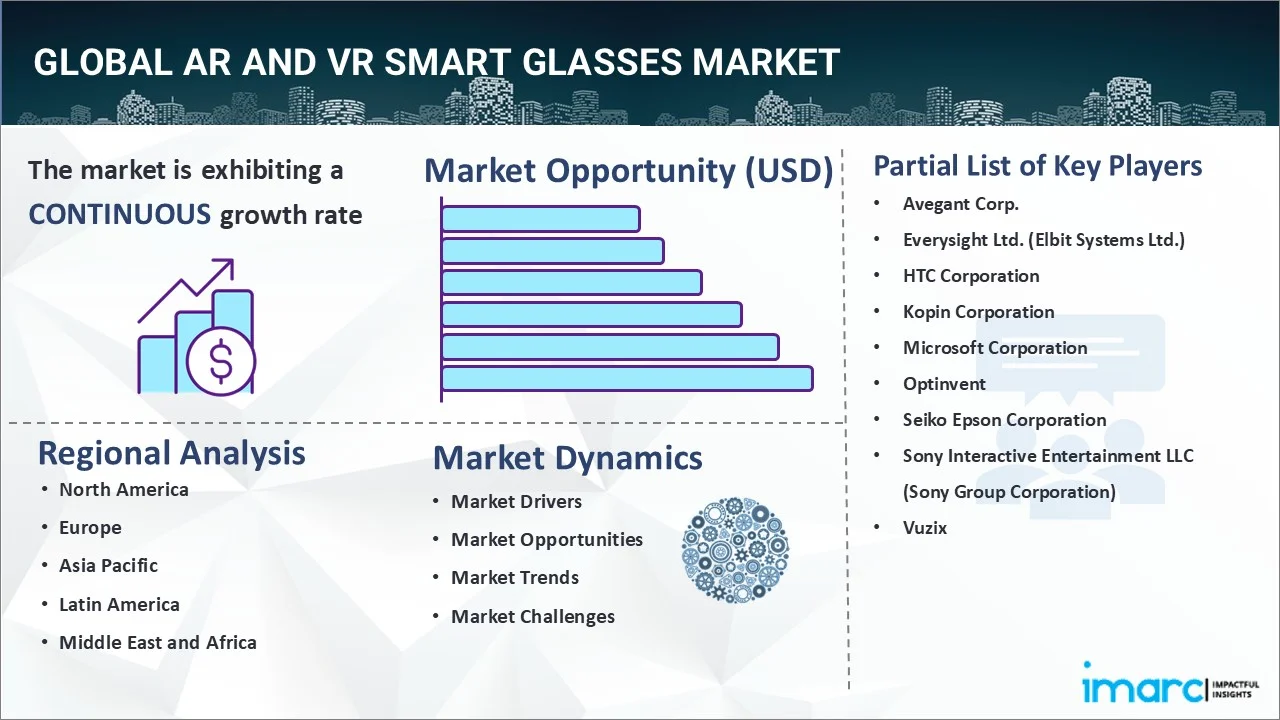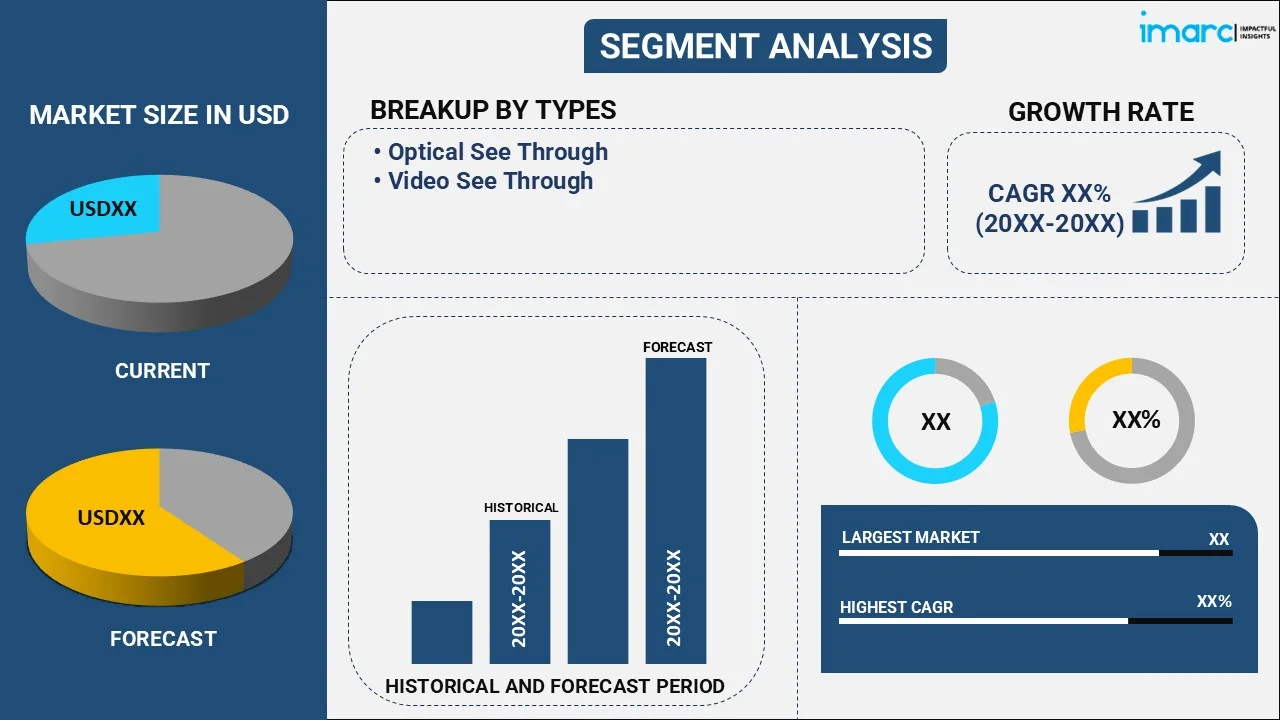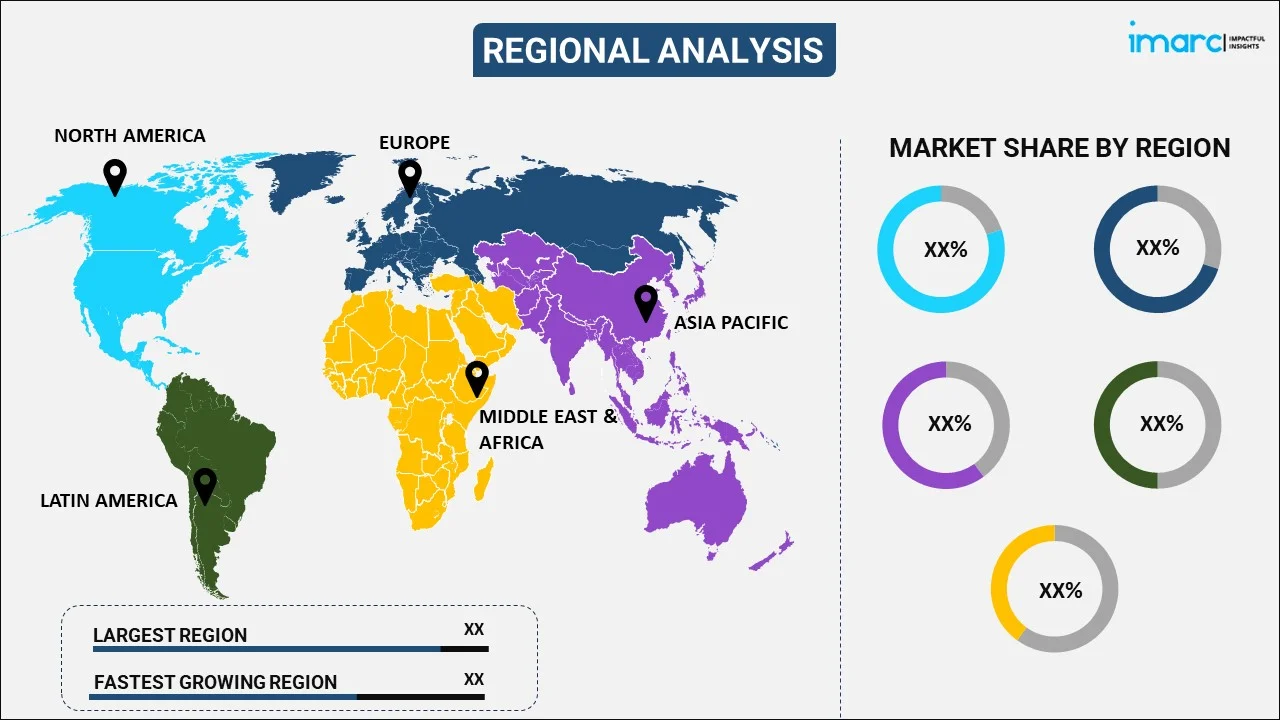
AR and VR Smart Glasses Market Report by Type (Optical See Through, Video See Through), End Use (Gaming Industry, Healthcare, Education, Military and Defense, and Others), and Region 2025-2033
AR and VR Smart Glasses Market Size:
The global AR and VR smart glasses market size reached USD 18.6 Billion in 2024. Looking forward, IMARC Group expects the market to reach USD 53.6 Billion by 2033, exhibiting a growth rate (CAGR) of 11.82% during 2025-2033. The market is rapidly evolving, driven by technology breakthroughs, widespread industrial acceptance, and rising consumer interest, with North America leading in innovation and uptake, despite high costs, giving prospects for broader application and strategic collaboration.
|
Report Attribute
|
Key Statistics
|
|---|---|
|
Base Year
|
2024
|
|
Forecast Years
|
2025-2033
|
|
Historical Years
|
2019-2024
|
|
Market Size in 2024
|
USD 18.6 Billion |
|
Market Forecast in 2033
|
USD 53.6 Billion |
| Market Growth Rate 2025-2033 | 11.82% |
AR and VR Smart Glasses Market Analysis:
- Major Market Drivers: Technological advancements, such as enhanced optics, sensors, and processors, which make these devices more effective and user-friendly, are expanding the market share. Furthermore, the widespread adoption of augmented reality (AR) and virtual reality (VR) smart glasses across numerous industries, combined with rising consumer interest in immersive gaming, is driving market expansion.
- Key Market Trends: The dominance of optical see-through AR smart glasses, which offer a seamless blend of digital and real-world experiences, is one of the notable trends. Aside from that, the integration of advanced technologies like artificial intelligence (AI) and fifth-generation (5G) to enhance the functionality of these glasses is fueling the market expansion.
- Geographical Trends: North America is dominating the market, owing to a strong technological infrastructure, high consumer adoption rates, and substantial investments in research. Other regions are also witnessing robust growth because of the favorable government support and presence of tech-savvy consumer base.
- Competitive Landscape: Some of the major market players in the AR and VR smart glasses industry include Avegant Corp., Everysight Ltd. (Elbit Systems Ltd.), HTC Corporation, Kopin Corporation, Microsoft Corporation, Optinvent, Seiko Epson Corporation, Sony Interactive Entertainment LLC (Sony Group Corporation), Vuzix, among many others.
- Challenges and Opportunities: Based on the latest AR and VR smart glasses market analysis, the high cost of AR and VR smart glasses, which can limit widespread consumer adoption, is a major challenge. However, the expanding application of smart glasses across different industries and integration of emerging technologies is offering considerable growth opportunities.

AR and VR Smart Glasses Market Trends:
Rapid Technological Advancements
Technological advancements are at the forefront of driving the AR and VR smart glasses market growth. Innovations in hardware and software have significantly enhanced the capabilities of these devices. For instance, Meta introduced improved Ray-Ban Smart Glasses in September 2023. These featured a new ultra-wide 12 MP camera capable of recording 1080p films for up to 60 seconds, as well as specially tuned speakers. Additionally, advancements in sensors and tracking technology have improved the accuracy and responsiveness of these devices, which is contributing to the AR and VR smart glasses market revenue. These sensors can precisely track head and eye movements, creating a more natural and interactive user experience. Besides this, the integration of more powerful and efficient processors, which enables these devices to run complex applications smoothly, reducing latency and increasing performance, is supporting the market growth.
Increasing Product Adoption in Various Industries
The widespread use of these devices across numerous industries is a crucial factor boosting the AR and VR smart glasses market value. These glasses are transforming medical education and surgery. Surgeons can use these gadgets to conduct remote consultations and even guide treatments, streamlining the process and improving patient results. Furthermore, smart glasses help workers in the manufacturing industry with complex assembly processes, maintenance, and quality control by overlaying critical information directly onto their field of vision. This reduces mistakes and improves efficiency. Besides this, the retail industry is also leveraging AR smart glasses to enhance customer experiences and optimize operations. This sector is predicted to increase at a rate of 5.54% per year, reaching $46304.9 billion by 2032. Retail employees can utilize these devices to monitor inventory, and customers can see things in their surroundings before making a purchase. This widespread industrial use not only confirms the utility of these gadgets, but also broadens the AR and VR smart glasses market scope.
Growing Consumer Interest
Growing consumer interest is a powerful catalyst for boosting the AR and VR smart glasses demand. Consumers are increasingly seeking immersive experiences that go beyond traditional screens. AR and VR smart glasses provide an unprecedented level of immersion, allowing consumers to step inside virtual worlds and interact with them in a realistic manner. Additionally, AR applications on smart glasses enhance everyday activities by overlaying digital information onto the real world, making tasks like navigation, shopping, and social interaction more interactive and convenient. The ability to access real-time information and digital content hands-free is a significant draw for consumers. Besides this, the use of AR and VR smart glasses in fitness and wellness is gaining traction. Virtual workout sessions and guided meditation programs are utilizing these devices to offer personalized and engaging experiences.
AR and VR Smart Glasses Market Segmentation:
IMARC Group provides an analysis of the key trends in each segment of the market, along with forecasts at the global, regional, and country levels for 2025-2033. Our report has categorized the market based on type and end use.
Breakup by Type:

- Optical See Through
- Video See Through
Optical see through accounts for the majority of the market share
The report has provided a detailed breakup and analysis of the market based on the type. This includes optical see through and video see through. According to the report, optical see through represented the largest segment.
Based on the latest AR and VR smart glasses market outlook, optical see-through smart glasses are dominating the segment due to their advanced technology and practical applications. These glasses use transparent displays to overlay digital information onto the real world, allowing users to simultaneously see the real and virtual environments. This feature makes them particularly valuable in various professional settings, such as healthcare and manufacturing, where real-time data visualization enhances efficiency and accuracy. Additionally, optical see-through glasses are also popular in consumer applications, including navigation, shopping, and social media interactions, as they provide a seamless blend of digital and physical worlds.
Breakup by End Use:
- Gaming Industry
- Healthcare
- Education
- Military and Defense
- Others
Gaming industry holds the largest share of the industry
A detailed breakup and analysis of the market based on the end use have also been provided in the report. This includes gaming industry, healthcare, education, military and defense, and others. According to the report, gaming industry accounted for the largest market share.
The gaming industry holds the majority of the AR and VR smart glasses market share due to the immersive and interactive experiences these devices provide. Gamers are seeking more engaging and realistic environments, and AR and VR smart glasses offer exactly that. These glasses enable players to step inside virtual worlds, interact with characters and objects in a lifelike manner, and experience gaming on an entirely new level. Additionally, the high demand for immersive gaming experiences has led to significant investments by game developers and tech companies in AR and VR technologies. Besides this, the gaming community's enthusiasm for new technologies and experiences ensures a steady and growing market for these devices.
Breakup by Region:

- North America
- United States
- Canada
- Asia-Pacific
- China
- Japan
- India
- South Korea
- Australia
- Indonesia
- Others
- Europe
- Germany
- France
- United Kingdom
- Italy
- Spain
- Russia
- Others
- Latin America
- Brazil
- Mexico
- Others
- Middle East and Africa
North America leads the market, accounting for the largest AR and VR smart glasses market share
The report has also provided a comprehensive analysis of all the major regional markets, which include North America (the United States and Canada); Asia Pacific (China, Japan, India, South Korea, Australia, Indonesia, and others); Europe (Germany, France, the United Kingdom, Italy, Spain, Russia, and others); Latin America (Brazil, Mexico, and others); and the Middle East and Africa. According to the report, North America represents the largest regional market for AR and VR smart glasses.
North America is the dominant region as highlighted in the recent AR and VR smart glasses market forecast due to its strong technological infrastructure, high consumer adoption rates, and significant investments in research. Additionally, the region is home to many leading technology companies and startups that are at the forefront of AR and VR innovation. This concentration of expertise and resources fosters a robust ecosystem for the development and commercialization of advanced smart glasses. Besides this, North American consumers are early adopters of new technologies, driving demand for the latest AR and VR devices. Furthermore, the presence of major industries, such as gaming, healthcare, and manufacturing, which are key end users of AR and VR smart glasses, is further boosting the market growth.
Competitive Landscape:
- The market research report has also provided a comprehensive analysis of the competitive landscape in the market. Detailed profiles of all major companies have also been provided. Some of the major market players in the AR and VR smart glasses industry include Avegant Corp., Everysight Ltd. (Elbit Systems Ltd.), HTC Corporation, Kopin Corporation, Microsoft Corporation, Optinvent, Seiko Epson Corporation, Sony Interactive Entertainment LLC (Sony Group Corporation) and Vuzix.
(Please note that this is only a partial list of the key players, and the complete list is provided in the report.)
- Based on the recent AR and VR smart glasses market overview, leading players are focusing on continuous innovation and strategic partnerships to maintain their competitive edge. They are heavily investing in research and development (R&D) to enhance the functionality, comfort, and user experience of their smart glasses. Additionally, latest AR and VR smart glasses market research indicates that companies are integrating advanced technologies such as AI, 5G connectivity, and improved optics to create more immersive and practical solutions. Besides this, they are forming partnerships with industry leaders across healthcare, manufacturing, and entertainment sectors to expand the applications of their devices. These strategic moves not only enhance the capabilities of their products but also broaden their market reach.
AR and VR Smart Glasses Market News:
- In June 2024: Avegant announced a strategic partnership with Vuzix Corporation, a leading producer of smart glasses and AR technology and products. Under this partnership, both companies with come together to create an optimized and complete AR display module that is intended to be used as an optical reference design for AI-enabled consumer smart glasses.
- In September 2023: Microsoft Corporation was awarded with a new order from the US Army for its advanced mixed reality goggles designed for combat situations.
AR and VR Smart Glasses Market Report Scope:
| Report Features | Details |
|---|---|
| Base Year of the Analysis | 2024 |
| Historical Period | 2019-2024 |
| Forecast Period | 2025-2033 |
| Units | Billion USD |
| Scope of the Report | Exploration of Historical Trends and Market Outlook, Industry Catalysts and Challenges, Segment-Wise Historical and Future Market Assessment:
|
| Types Covered | Optical See Through, Video See Through |
| End Uses Covered | Gaming Industry, Healthcare, Education, Military and Defense, Others |
| Regions Covered | Asia Pacific, Europe, North America, Latin America, Middle East and Africa |
| Countries Covered | United States, Canada, Germany, France, United Kingdom, Italy, Spain, Russia, China, Japan, India, South Korea, Australia, Indonesia, Brazil, Mexico |
| Companies Covered | Avegant Corp., Everysight Ltd. (Elbit Systems Ltd.), HTC Corporation, Kopin Corporation, Microsoft Corporation, Optinvent, Seiko Epson Corporation, Sony Interactive Entertainment LLC (Sony Group Corporation), Vuzix, etc. |
| Customization Scope | 10% Free Customization |
| Post-Sale Analyst Support | 10-12 Weeks |
| Delivery Format | PDF and Excel through Email (We can also provide the editable version of the report in PPT/Word format on special request) |
Key Benefits for Stakeholders:
- IMARC’s industry report offers a comprehensive quantitative analysis of various market segments, historical and current market trends, market forecasts, and dynamics of the AR and VR smart glasses market from 2019-2033.
- The research report provides the latest information on the market drivers, challenges, and opportunities in the global AR and VR smart glasses market.
- The study maps the leading, as well as the fastest-growing, regional markets. It further enables stakeholders to identify the key country-level markets within each region.
- Porter's five forces analysis assists stakeholders in assessing the impact of new entrants, competitive rivalry, supplier power, buyer power, and the threat of substitution. It helps stakeholders to analyze the level of competition within the AR and VR smart glasses industry and its attractiveness.
- The competitive landscape allows stakeholders to understand their competitive environment and provides insight into the current positions of key players in the market.
Key Questions Answered in This Report
The global AR and VR smart glasses market was valued at USD 18.6 Billion in 2024.
We expect the global AR and VR smart glasses market to exhibit a CAGR of 11.82% during 2025-2033.
The rising adoption of AR and VR glasses, as they can record still images, videos, and audio remotely, share their point of view in real-time, access information hands-free, exchange data, etc., is primarily driving the global AR and VR smart glasses market.
The sudden outbreak of the COVID-19 pandemic has led to the growing deployment of AR and VR smart glasses, as they can enhance and replace existing technologies within enterprise supply chains, thereby increasing workplace efficiency, productivity, compliance, etc.
Based on the type, the global AR and VR smart glasses market has been segregated into optical see through and video see through. Currently, optical see through holds the largest market share.
Based on the end use, the global AR and VR smart glasses market can be bifurcated into gaming industry, healthcare, education, military and defense, and others. Among these, the gaming industry exhibits clear dominance in the market.
On a regional level, the market has been classified into North America, Asia-Pacific, Europe, Latin America, and Middle East and Africa, where North America currently dominates the global market.
Some of the major players in the global AR and VR smart glasses market include Avegant Corp., Everysight Ltd. (Elbit Systems Ltd.), HTC Corporation, Kopin Corporation, Microsoft Corporation, Optinvent, Seiko Epson Corporation, Sony Interactive Entertainment LLC (Sony Group Corporation), and Vuzix.
Need more help?
- Speak to our experienced analysts for insights on the current market scenarios.
- Include additional segments and countries to customize the report as per your requirement.
- Gain an unparalleled competitive advantage in your domain by understanding how to utilize the report and positively impacting your operations and revenue.
- For further assistance, please connect with our analysts.
 Inquire Before Buying
Inquire Before Buying
 Speak to an Analyst
Speak to an Analyst
 Request Brochure
Request Brochure
 Request Customization
Request Customization




.webp)




.webp)












